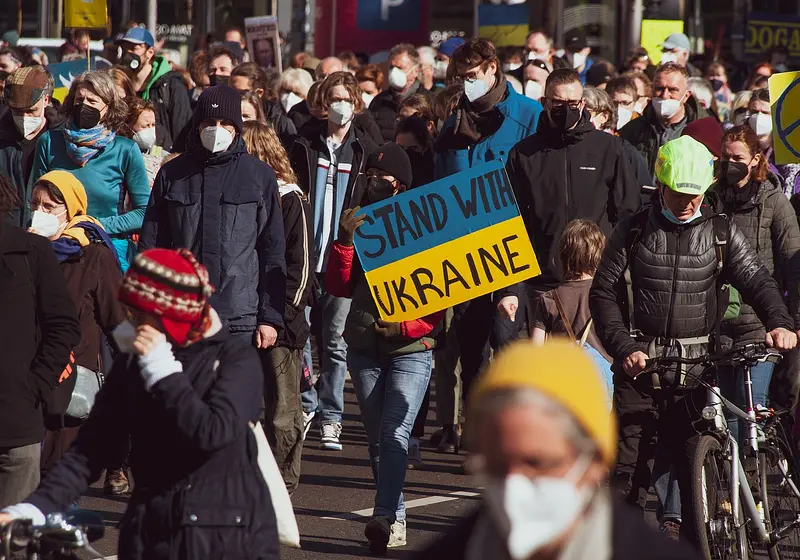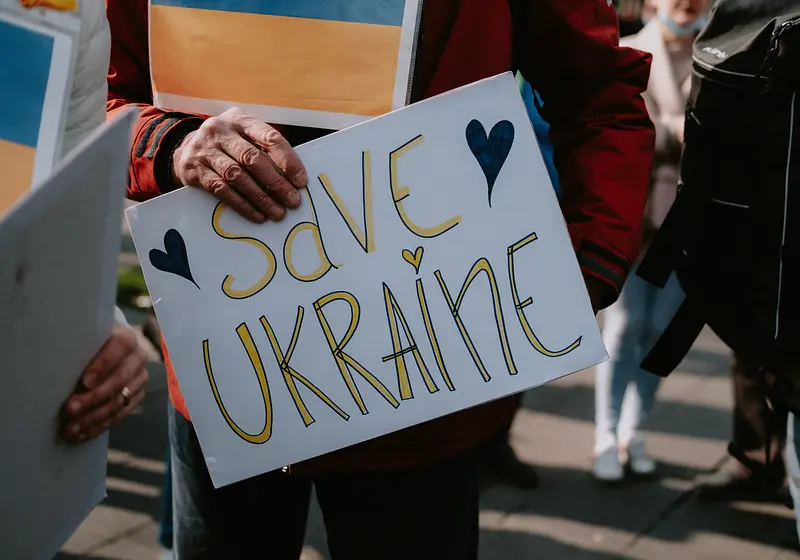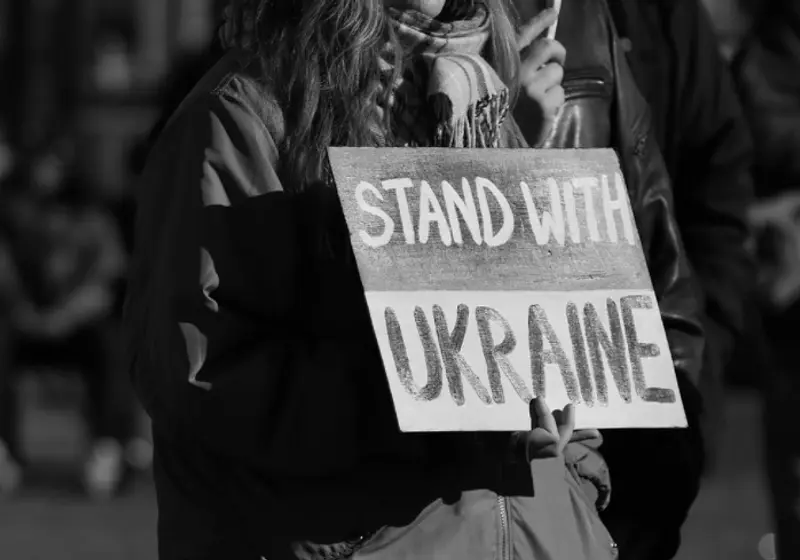An 8 year Ukraine girl confronts a Russian soldier telling him to go back to his country. This is courage simplicitta. pic.twitter.com/0CiT7JJdVg
— Ifedolapo Osun (@IfedolapoOsun) February 27, 2022
The current state of Ukraine is undeniably a cause for international concern, but with media outlets channeling their coverage on the situation, other world conflicts in the Global South, many of which have been raging for decades, threaten to be obscured.
In February 2022, photos of an 8-year-old girl threatening a soldier were shared across hundreds of posts with the caption "The moment an 8 year Ukrainian girl confronts a Russian soldier telling him to go back to his country." Internet audiences found the content "morale-boosting" and inspiring considering the relevant subject matter, and contributed to its garnering over 12 million views on platforms such as TikTok.
The problem is that the pictured girl is not, in fact, Ukranian; the photo itself was not even taken in Kyev. In actuality, it just so happens that the screencaps originate from a 10-year-old video filmed in the West Bank of Palestinian activist Ahed Al-Tamimi confronting an Israeli officer. Despite the misinformation, the video garnered significant circulation on a level it simply had not in the past, when the girl was rightfully assumed to be Palestinian.
In response to this duality, Twitter users decried the hypocrisy in the visibility of the ongoing Palestinian issue in relation to the Ukraine situation, claiming Tahimi attracted a higher level of audience attention when she was believed to be white. The example highlights what I believe to be the severity of the current media obsession with Ukraine, the element of race involved, and its implications for the visibility of other pressing conflicts.
Let us slide into your dms 🥰
Get notified of top trending articles like this one every week! (we won't spam you)Bias and Reception
As pointed out by online communities and newspapers alike, the war in Ukraine has presented the opportunity for media outlets to reveal a double standard in reporting on war. The crux of the coverage in Ukraine, especially by white journalists, has been on the apparent absurdity of the conditions of war, rather than simply the developments; in other words, surprise that a conflict typically relegated to third-world status is now seen in a developed nation (with developed usually being code for white).
A famous example is the case of CBS's Charlie D'Agata, who affirmed in February that “this (Ukraine) isn’t a place, with all due respect, like Iraq or Afghanistan, that has seen conflict raging for decades.
This is a relatively civilized, relatively European – I have to choose those words carefully, too – city, one where you wouldn’t expect that, or hope that it’s going to happen.” Far from being the only one, D'Agata's comments point to a worrying trend of comparative media coverage in Ukraine which professes the differences between the "civilized" white Ukranians, and the "othered" non-white refugees, expressing preference for the former. Notice how D'Agata's comments emphasize surprise in the face of the events.
By classifying Ukraine as a place one hopes conflict should not occur, such comments reinforce an implicit notion that, unlike in Europe, war in the Middle-East and Global South is trivial, almost undeserving of attention.
“Civilized” pic.twitter.com/AiU7uVmjMr
— Imraan Siddiqi (@imraansiddiqi) February 26, 2022
Take the Quiz: Which Indian city is the perfect holiday spot for you!?
Let's match you with an Indian city that you would love!
Internet Response
Apart from the "othering", Ukranian coverage has suffered heavily from Eurocentrism - indeed, a simple Google Trends comparison reveals interest in the Russo-Ukranian War has almost dramatically trumped searches for other crises - including those in Syria, Afghanistan, and Yemen - all of which have been transpiring for longer and with more casualties than the former. Searches for "Ukraine Conflict" on Google have already exceeded 3 billion, surpassing the 356 million results for "Palestine" and 2 billion for "Syria Conflict," despite the conflict having been initiated less than a year ago.
The sheer dimensions of search results suggests, firstly, that media coverage on Ukraine has sparked conversation on a level unmatched by previous or ongoing conflicts, and secondly, that the topic itself reverberates with a wider audience than the aforementioned.
Google Trends comparison of the topics "Russo-Ukrainian War," "Syrian Civil War," "Israeli-Palestinian Conflict," and "Yemeni Civil War."
Why then, among the seemingly endless reporting of Ukraine, has such a comparatively lower amount of attention been afforded to the fact that civilians in Syria "are enduring the worst economic crisis since the war began," over 60% of the population facing food insecurity on top of deteriorating pandemic response and terrible weather conditions, or the implications of Fathi Bashagha's recent ascension as Prime Minister in Libya as presenting the chance for conflict to spark anew through border clashes and the mobilization of armed groups? Since the genesis of the Ukranian conflict, how much coverage has been maintained on what is still considered the worst humanitarian crisis in the world - Yemen - with over 80% of the population still in need of "humanitarian aid and protection," and 19 million people predicted to face food shortages in 2022?
How is it possible that little more than a handful of articles have even considered offhand the ramifications of reduced wheat supplies from Ukraine on the already critical famines faced in the country, let alone reported on ongoing violence with as much consistency and interest as the former?
As proclaimed in a BBC Op-ed from March, media and institutional focus on Ukraine are encapsulated in the adage "we are all equal, but some are more equal than others" from Orwell's Animal Farm. Excluding the novella's political motivators, the message can be cleanly applied; the meaning of "equal" is subverted to generate semantic juxtaposition and irony - how could some be more equal than others? They may as well be unequal.
Just as the pigs in Animal Farm distort their initial message to preserve power relations, so too can it be said that much of the media surrounding Ukraine has failed to fulfill its promises of unbiased reporting and informational democratization by lending more and more attention to the issue in a mutually exclusive fashion. It is no surprise, as a result, to observe a decline in the attention paid to other conflicts.
'Now the unthinkable has happened to them, and this is not a developing, third world nation, this is Europe.' pic.twitter.com/BFYvql7iie
— j (@jrc1921) February 27, 2022
Real-World Implications
At the start of the war, a reporter from ITV made headlines by claiming: “Now the unthinkable has happened to them. And this is not a developing, third world nation.
This is Europe!" The irony in this statement originating from the automatic equation of "Europe" with peace, an idea which does not hold up to the slightest bit of historical scrutiny. Says one Twitter user, "This is Europe" they cry, forgetting the sheer multitude of conflicts started in Europe or by Europeans." This claim assimilates into the current journalistic technique of association - the inherent goodness of the European Ukranians is affirmed to juxtapose the surprise of their horrible conditions and imply that, unlike in the Global South, war in Europe is an alien concept.
The formation of this narrative is significant in reinforcing Western audiences' prejudices and particularly, in trivializing conflicts in third-world countries which, in the long term, produces support for such statements as that declared by Bulgarian Prime Minister Kiril Petkov: “These (Ukranians) are not the refugees we are used to. These are people who are Europeans, so we and all other EU countries are ready to welcome them.
These are … intelligent people, educated people … So none of the European countries is afraid from the immigrant wave that is about to come." The acceptance of such messages has set the stage for support of policies which favor, for examples, the reception of Ukranian refugees over others.
In other words, the translation of this media bias into real-world government. Over 3 million Ukranians were accepted into neighboring countries within the first month alone - it took the same number of Syrians over two years to reach such a milestone in Europe. A worrying example is the hypocrisy of neighboring Poland, which has accepted more than 2 million Ukranians while having entered into a state of emergency just last year over a few thousand Afghan and Iraqi refugees crossing from nearby Belarus.
As mentioned by Vox: "Polls across the EU reflect a deep wariness about certain immigrants. Generally, European countries are less welcoming to immigrants of races and ethnicities that differ from their predominantly white populations." Some are more equal than others. The dichotomy between the reception of refugees in and outside Ukraine has certainly brought this closer to the limelight, exacerbated by media coverage.
Bias or Coincidence?
It is, of course, important to consider that other factors - some completely unrelated - have, too, played a role in the current public obsession with Ukraine. For instance, the war is seen as a one-sided conflict between an "agressor" - Russia - and a "victim" (although this is also politically motivated). The binary conceptualization - at least in its perception - and unity against a mutual aggressor, could be one of the reasons why the situation in Ukraine has uniquely resonated with audiences.
For comparison, the Syrian civil war involves a tangled heap of rebel groups, armed independence movements, religious extremists, foreign-backed militants and government forces: all of this is less conducive to virility than the "us v them" dichotomy seen in Ukraine. But why then, how is it that online response to the crisis in Afghanistan has been reduced? After all, the issue is also represented in a binary.
One might bring up the factor of geographic proximity as one of the reasons why Ukrainian refugees have been more widely accepted, as well as the influence of the politically motivated intentions of NATO, although the argument only goes so far considering modern Europe's history of acidity towards nonwhite refugees.
Independently of how the proverbial cake is sliced, it seems, Western bias and Eurocentrism are inescapable. So, to conclude, why is it that Ukraine has amassed such mass coverage in comparison to other wars? Why is it that the 8-year-old Palestinian girl was assumed to be Ukranian?
Would she have been equally supported had users known she was confronting not a Russian but an Israeli? Would the legitimacy of her criticism have been equally affirmed? In the context of current media, I argue it is more likely than not for it not to have been so: Western bias in coverage of Ukraine has already erased much of our awareness of parallel conflicts whose urgency still needs to be maintained.
Ultimately, it is neither justified to decry #StandwithUkraine while willfully ignoring Afghanistan, Syria, Libya, Yemen, Myanmar, etc. etc., nor to declare the Ukranian crisis overinflated and completely undeserving of attention - these are, after all, refugees fleeing war. A truly unbiased understanding would be to acknowledge the plight of Ukranians, and remember that it is but the loudest in a crowded room.














